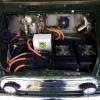 image.jpeg 40.69K
15 downloads
image.jpeg 40.69K
15 downloadsLooks like an old car, right? Yeah it is. But check out the plaque!
 image.jpeg 48.87K
24 downloads
image.jpeg 48.87K
24 downloadsIt's an EV from 1915! Sure, ok, it goes 20 mph but all the cars went 20 mph back then. It has an 80 MILE range!!!! Eighty miles on a single charge, electric vehicle, made in 1915!
So electric vehicles can't be that complicated. And they are not. Here's a simple diagram I drew on my iPad to show the different parts involved. It is quite simple:
 image.jpeg 56.94K
35 downloads
image.jpeg 56.94K
35 downloadsTry drawing something like this for a regular engine. It would involve air, electricity and gas, and how you need to perfect those substances and combine them to get the pistons to turn. It would be far more complicated.
Let me go through this quickly for you.
Outlet - that's your wall electric outlet.
Charging thing - there's many different kinds. Basically what converts the power from your wall to the power you need to plug into your car. If you go to a charging station, that's what it is, or you can buy little ones for home. I got a neat one that can plug into 110V or 240V, and is small enough for me to throw in the trunk so I always have it with me and will never be stranded. Check it out: http://www.evwest.co...products_id=298
Plug - where you plug into the car. Your fuel cap equivalent.
Battery charger - something like a laptop charger but bigger. It takes the electricity and pumps it into the batteries. There are many different kinds. The guys at EV West told me the best one for my Tesla batteries, and since I wanted a faster charging time they recommended that I get two. The second one is on a switch. This way if I pull up to an outlet that might have a small fuse I only use one charger, or if I'm at a well fused outlet I can use both chargers and charge in half the time.
Battery - The electricity goes from the charger to the batteries, and there your electric fuel is stored. The batteries need to be wired in such a way to come to a total of (roughly) 110V for the electric motor that I used. There are other motors that need a different battery configuration, like 48V or 300something V....
Contactor Box - a fancy name for a plastic box that keeps the relays dry. If they got wet there would be problems. It has two glorified relay switches in there, one for the DC to DC converter, one for the Controller. It also has a shunt in there to give a gauge the correct battery capacity reading, and another thing to tell the chargers when to stop charging because the batteries are full.
DC to DC Converter - this is basically the equivalent of the alternator. It charges your regular Mini battery so that the lights and the horn and the wipers work.
Controller - this guy does the magic. So a battery is DC current. The motor is an AC motor, using AC electricity. The controller takes the DC current from the battery and chops it up to make AC current. If you want to drive slow it chops up the current slowly. If you want to drive fast it chops it up faster.
It can be programmed to do all sorts of cool stuff. Like when you're stopped at a traffic light the car can "crawl" like an automatic, or not, it also regenerates electricity with braking or while coasting, you can determine how much or how little power you want, all sorts of stuff.
The controller gets pretty hot. So it needs to sit on a heat sink. The guys at EV West designed a cooling plate that connects to the type of cooling system that you would install in a water cooled computer, and it keeps the controller cool.
Motor - pretty straight forward AC, three phase electric motor, used for pumps or other stuff. There are many different kinds. There are also DC motors that would use a different configuration. AC motors are better, but there's a whole science behind the reasoning. I just went with the motor that EV West told me would be best for my car.
Plate - reading other people's EV stories usually entails a whole section on the plate. Essentially, how do you plug the electric motor to the rest of the drive train. For me it was super easy, because I had already done the Suzuki G-10 conversion - which of course also included the subframe. And a company in Canada makes a plate to connect directly to the Suzuki G-10 transmission. It was simply plug-and-play. (Or at least I thought!)
The rest of the car is the same. It's best to keep the manual transmission on the car, because an automatic transmission sucks up too much effort from the engine and it's all wasted.
There's two schools of thought as to whether to use a clutch or not. The concept is that since the electric motor is not spinning when you are stopped, you can change gears freely. While in theory it is not necessary to disengage an engine that is not spinning, in practice it doesn't quiet work so well. When it comes down to it, if you want a performance car that works well, use the clutch.
In the end the car drives differently than a manual even though you have a clutch pedal and a stick shift, but I'll go into that more later on. It's actually a more "natural" way to drive than the conventional manual car. It's also quite easy for someone who has no idea what a stick shift is, to drive the car as if it were an automatic (and just ignore the third pedal).















